Chicago scientists are testing an unhackable quantum internet in their basement closet
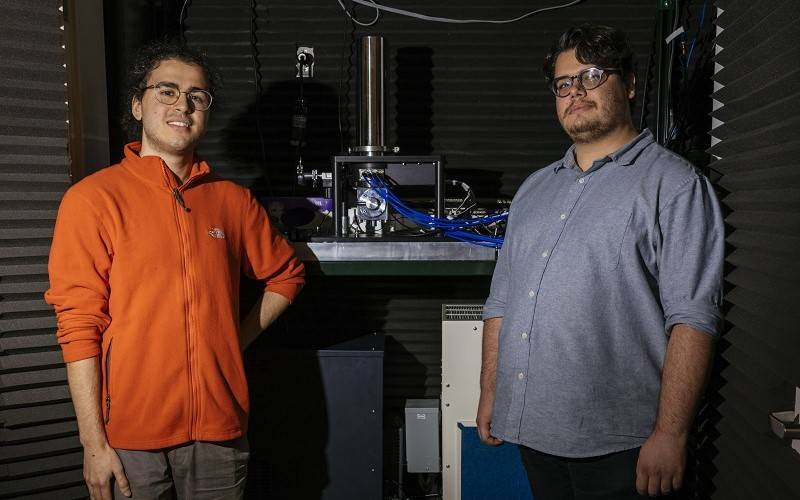
Graduate students Cyrus Zeledon, left, and Grant Smith pose for a portrait in front of a superconducting nanowire single-photon detector at the quantum computing lab of University of Chicago’s Eckhardt Research Center on Oct. 4, 2022.
16:48 JST, October 10, 2022
CHICAGO – The secret to a more secure and powerful internet – one potentially impossible to hack – might be residing in a basement closet seemingly suited for brooms and mops.
The 3-foot-wide cubby, in the bowels of a University of Chicago laboratory, contains a slim rack of hardware discreetly firing quantum particles into a fiber-optic network. The goal: to use nature’s smallest objects to share information under encryption that cannot be broken – and eventually to connect a network of quantum computers capable of herculean calculations.
The modest trappings of Equipment Closet LL211A belie the importance of a project at the forefront of one of the world’s hottest technology competitions. The United States, China and others are vying to harness the bizarre properties of quantum particles to process information in powerful new ways – technology that could confer major economic and national-security benefits to the countries that dominate it.
Quantum research is so important to the future of the internet that it is drawing new federal funding, including from the recently adopted Chips and Science Act. That’s because, if it pans out, the quantum internet could safeguard financial transactions and health-care data, prevent identity theft and stop hostile state hackers in their tracks.
Just this past week, three physicists shared the Nobel Prize for quantum research that helped pave the way for this future internet.
Quantum research still has plenty of obstacles to overcome before it reaches widespread use. But banks, health-care companies and others are starting to run experiments on the quantum internet. Some industries are also tinkering with early-stage quantum computers to see whether they might eventually crack problems that current computers can’t, such as discovering new pharmaceuticals to treat intractable disease.
Grant Smith, a graduate student on the University of Chicago’s quantum research team, said it’s too soon to imagine all of the potential applications.
“When people first made the rudimentary internets connecting research-level computers and universities and national labs, they couldn’t have predicted e-commerce,” he said during a recent tour of the university’s labs.
The study of quantum physics began in the early 20th century, when scientists discovered that the universe’s tiniest objects – atoms and subatomic particles – behave in ways unlike matter in the large-scale world, such as appearing to be in multiple places at the same time.
Those discoveries, called the first quantum revolution, led to new technologies such as lasers and the atomic clock. But research now is bringing scientists closer to harnessing more of the quantum world’s peculiar powers. David Awschalom, a professor at University of Chicago’s Pritzker School of Molecular Engineering and leader of the quantum team, calls this the second quantum revolution.
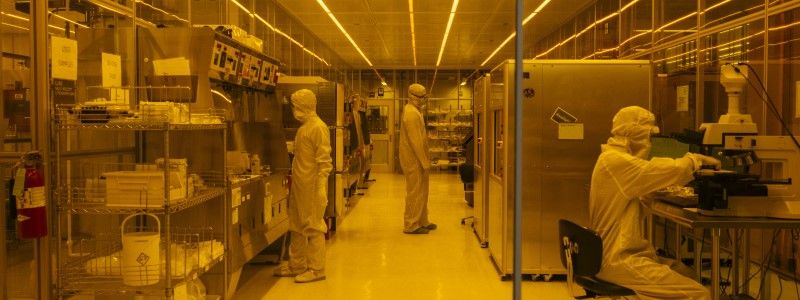
The lithography bay of the Pritzker Nanofabrication Facility of University of Chicago’s Eckhardt Research Center on Oct. 4, 2022.
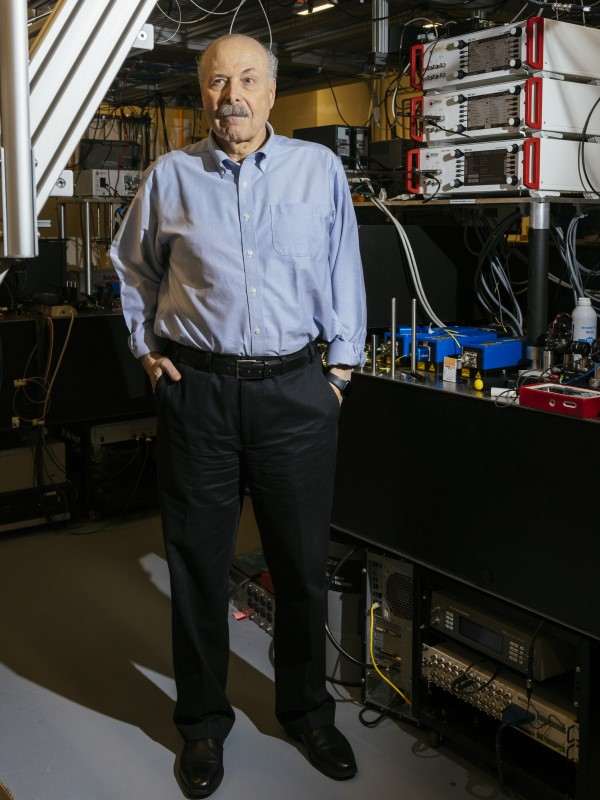
Professor David Awschalom, founding director of the Chicago Quantum Exchange, poses for a portrait in the quantum computing lab at University of Chicago’s Eckhardt Research Center on Oct. 4, 2022.
The field is “trying to engineer the way nature behaves at its most fundamental level to our world, and to exploit these behaviors for new technologies and applications,” he said.
Existing computers and communication networks store, process and transmit information by breaking it down into long streams of bits, which are typically electrical or optical pulses representing a zero or one.
Quantum particles, also known as quantum bits, or qubits, can exist as zeros and ones at the same time, or in any position between, a flexibility known as “superposition” that allows them to process information in new ways. Some physicists compare them to a spinning coin that is simultaneously in a heads and tails state.
Quantum bits can also exhibit “entanglement,” where two or more particles are inextricably linked and mirror each other exactly, even when separated by great physical distance. Albert Einstein called this “spooky action at a distance.”
The closet hardware connects to a 124-mile fiber-optic network running from the university’s campus on Chicago’s South Side to two federally funded labs in the western suburbs that are collaborating on the research – Argonne National Laboratory and Fermi National Accelerator Laboratory.
The team is using photons – which are quantum particles of light – to dispatch encryption keys through the network to see how well they travel through fibers that pass under highways, bridges and toll booths. Quantum particles are extremely delicate and have the propensity to malfunction at the slightest disturbance such as a vibration or temperature change, so sending them over long, real-world distances is tricky.
In the university’s basement closet, a piece of hardware built by the Japanese company Toshiba emits pairs of entangled photons and sends one from each pair through the network to Argonne, which is 30 miles away, in Lemont, Ill. One encryption key is encoded on a string of photon pairs.
Because the pairs are entangled, they are fully in sync with each other. “In a sense, you can view them as a single piece of information,” Awschalom said.
When the traveling photons reach Argonne, scientists there measure them and extract the key.
Anyone attempting to hack into the network to intercept the key will fail, Awschalom said, because the laws of quantum mechanics say that any attempt to observe particles in a quantum state automatically alters the particles and destroys the information being transmitted. It also alerts the sender and receiver about the attempted eavesdropping.
This is one reason scientists believe the technology holds such promise.
“There are huge technical difficulties to overcome, but you could argue this could become as important as the tech revolution of the 20th century that gave us the laser and the transistor and atomic clock and, therefore, GPS and the internet,” Steven Girvin, a physics professor at Yale, said about recent discoveries in quantum technology.
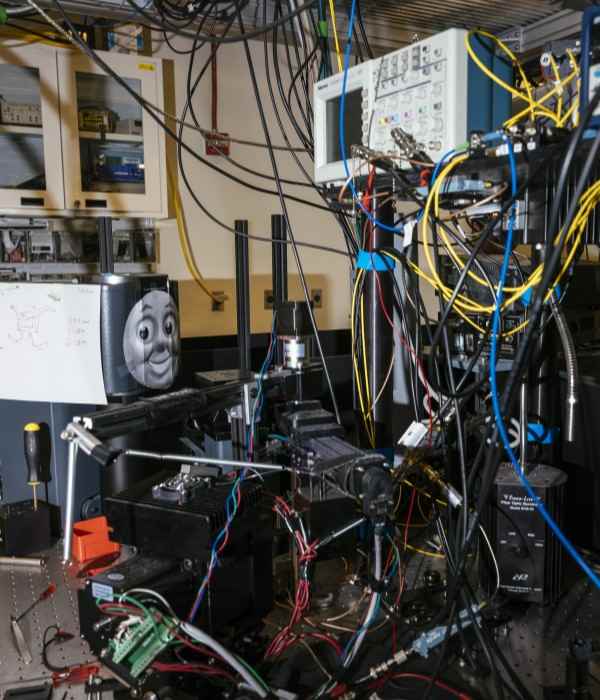
A picture of Thomas the Tank Engine is displayed on a piece of equipment in the quantum computing lab at the University of Chicago’s Eckhardt Research Center on Oct. 4, 2022.
In a lab next to the closet, Awschalom and his colleagues are attempting to develop new devices that will help the photons carry information across greater distances. The room is a cramped tangle of millions of dollars of laboratory equipment, lasers and a photo of Thomas the Tank Engine, because one of the instruments makes a constant chugging noise. “It’s for, I guess, like, comedic value,” graduate student Cyrus Zeledon said.
One problem they’re trying to fix: As the tiny particles of light travel through the network’s glass fibers, imperfections in the glass cause the light to attenuate after a certain distance. So the researchers are attempting to develop devices that could catch and store information from the light particles as they travel and then send the information onward again with a fresh particle – like a photonic Pony Express.
Wearing purple latex gloves to avoid damaging the surface, Zeledon held up a tiny circuit board containing two chips of silicon carbide that he and his colleagues are testing as a device to store and control information from quantum bits. Later that day, Zeledon was planning to cool the chips to super low temperatures and examine them under a microscope, to look for quantum bits that he had implanted in the chips that he could then manipulate with microwaves into exchanging information with photons.
On the other end of the network on a recent morning, Argonne scientist Joe Heremans, who was previously Awschalom’s student, apologized for the loud chugging sound also reverberating around his lab. Where was his picture of Thomas the Tank Engine? “We attempt to be slightly more professional here,” he joked.
Heremans and his colleagues are also trying to develop new devices and materials to help photons carry quantum information across greater distances. Synthetic diamonds are one material that holds promise, he said, nodding toward a reactor that was growing diamonds at the glacial pace of nanometers per hour.
Federal funding from the National Quantum Initiative Act, passed by Congress and signed by President Donald Trump in 2018, recently helped the lab buy a second reactor that will grow diamonds faster. The Chips and Science Act, signed by President Biden in August, is providing additional support for research and development that will bolster quantum efforts.
In a corner of his lab, Heremans pointed to a Toshiba machine identical to the one at the University of Chicago. From there, a jumble of colorful wires carries signals to and from the network, which, after leaving the lab, runs in a short loop under a nearby Ikea and Buffalo Wild Wings before shooting out in either direction to the university and Fermilab.
Scientists are experimenting with similar testbeds in Boston, New York, Maryland and Arizona. Experimental networks also exist in the Netherlands, Germany, Switzerland and China.
The goal is to someday connect all of these testbeds, via fiber and satellite links, into a fledgling quantum internet spanning the United States and eventually, the globe. As the network grows, it could ideally be used not only for sending encrypted information, but for connecting quantum computers to raise their processing power, the way the cloud does for current computers.
“The idea of a quantum internet is something that is very much in the process of being born,” Smith said.
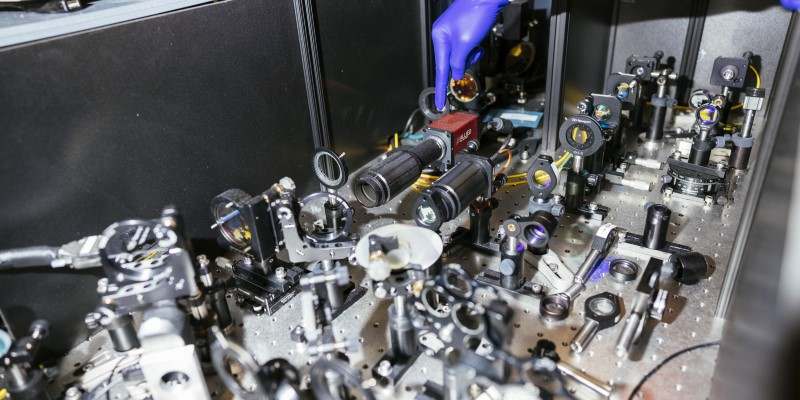
Graduate student Cyrus Zeledon points to a “home-built” specialized microscope in the quantum computing lab at the University of Chicago’s Eckhardt Research Center on Oct. 4, 2022.





